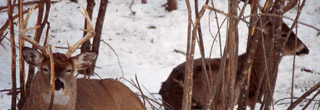My son Dave’s routine upon arriving at 1 PM at his black bear stand/bait site 40-some years ago was fairly standard for us Nordbergs. Though his bait crib had been torn apart by a bear during the previous 24 hours, it still contained plenty of bait so Dave went straight to the base of the tree trunk at the edge of his 7-yard-diameter bait site opening opposite his stand tree and poured half of the honey from a jar into an empty bowl-like watermelon rind (previously cleaned out by a bear) and placed it on the ground between the tree trunk and the brush stacked behind it where one-half of the bowl would be visible from his portable tree stand. Then, using a short stick, he removed six limp-fried slices of bacon from a plastic bag and hung them on limbs in the brush pile. His “positioning baits” were then ready to ensure a bear would be standing quartering away when he released an arrow at it from his stand nine feet above the ground — setting up a deadly heart/lung shot with an easy to trail exit wound. Minutes later, Dave was seated in his stand, face covered with a camo headnet, arrow nocked and resting across his bow, his half full jar of honey stored out of the way on his stand platform beneath his seat.
About four hours later, his stand tree began to tremble. Turning his head a bit, he discovered a bear weighing about 250 pounds (not the 350+ pounder he was expecting) was climbing his tree. Figuring it would flee the moment it realized a human was perched above it, Dave froze. This realization didn’t occur until the beat was reaching for the jar of honey. After bear and hunter stared at one another a few long seconds, the bear backed down, sans honey, and quickly departed.
What that bear had just proven, black bears readily smell food and therefore humans as well in trees nine or more feet above the ground. That bear did not react to Dave’s odors accompanying the sweet odor of honey because it had become accustomed to smelling them during the two weeks before the opener when Dave had been regularly hauling (on a plastic toboggan) more bait to the site midday.
Having often watched mature whitetails halt upon discovering human trail scents and then stare in the direction taken by the humans, it is certain whitetails have a greater sense of smell than black bears, meaning, whitetails can also readily smell humans using elevated stands (contrary to popular belief decades ago). Since the 1970s, via magazine articles (nearly 800 of them), books (15), videos, and hundreds of nationwide seminars, I’ve been regularly warning hunters about this. Considering the great number products now available that claim to eliminate scents of deer hunters, most hunters now realize this is true.
The trouble is, most odor eliminating products have distinctive odors of their own, their effectiveness (those I’ve tested) is short-lived and some odors common to deer hunters such human breath and rubber boot soles cannot be eliminated. The only sure way to be completely certain you cannot be smelled by intended quarries is 1) approach them from downwind or crosswind (with the crosswind angling toward your right or left cheek) and then 2) stand hunt downwind or crosswind of where you expect to see a deer.
Keep in mind, while hunting, many deer will pass downwind of you and responses of downwind whitetails to your airborne human odors will be far less ruinous to hunting when not strong, meaning, while hunting whitetails, it is still a good idea to be as odor-free as possible.

